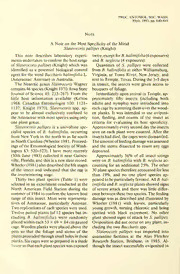
A Note On The Host specificity Of The Mirid Slaterocoris pallipes PDF
Preview A Note On The Host specificity Of The Mirid Slaterocoris pallipes
PROC. ENTOMOL. SOC. WASH. 95(4), 1993, pp. 640-641 Note A Note on the Host Specificity ofthe Mind Slaterocorispallipes (Knight) This note describes laboratory experi- twice,exceptforB. halimifolia(6exposures) ments undertaken toconfirm thehost range and B. neglecta (4 exposures). ofSlaterocorispallipes (Knight) which was Quantities of S. pallipes were collected identified as a potential biological control from B. halimifolia at either Williamsburg, agent for the weed Baccharis halimifolia L. Virginia, or Toms River, New Jersey, and (Asteraceae: Astereae) in Australia. sentto Temple, Texas. Duringthe 3-5 days The Nearctic genus Slaterocoris Wagner in transit, the insects were given access to contains46 species(Knight 1970. IowaState bouquets offoliage. Journal ofScience 45: 233-267). From the Immediately upon arrival in Temple, ap- little host information available (Kelton proximately fifty insects (including both mi- 1968. Canadian Entomologist 100: adults and nymphs) were introduced into ll37; Knight 1970), Slaterocoris spp. ap- eachcagebyscatteringthemoverthewood- pear to be almost exclusively confined to en planks. It was intended to use oviposi- theAsteraceaewith most speciesusingonly tion, feeding, and counts of the insect as one plant genus. criteria for evaluating its host specificity. Slaterocoris pallipes is a univoltine spe- Approximatelyeveryseconddaytheinsects cialist species of B. halimifolia, occurring seen on each plant were counted. After the from New York in the north to as far south insectshaddied, thecagesweredismantled. asNorth Carolina (Wheeler 1981. Proceed- Theamountoffeedingdamagewasassessed ings ofthe Entomological Society ofWash- and the stems dissected to count any eggs ington 83: 520-523). I have more recently deposited. (30th June 1983) collected it near Gaines- Approximately 56% of all insect sitings ville, Florida, andthis isanewstaterecord. were on B. halimifolia with B. neglecta ac- Wheeler(1981)alsodescribedthelifestages counting for an additional 25%. The other of the insect and indicated that the egg is 30 plant speciesthereforeaccountedforless the overwintering stage. than 19%, and no one plant species ap- Thirty two plant species (Table 1) were pearedtobeparticularlyfavored. AllB. hal- selected in an experiment conducted at the imifoliaandB. neglectaplantsshowedsigns North American Field Station during the ofsevere attack and there was little differ- summerof1984 to confirm the known host encebetweenthesetwospecies. Thefeeding range ofthis insect. Most were representa- damage was as described and illustrated by tives of Asteraceae, particularly Astereae. Wheeler (1981) with leaves, particularly Two replications ofeach species were used. young growth, turning chlorotic and being Twelve potted plants (of 12 species but in- spotted with black excrement. No other cluding B. halimifolia) were randomly plant showed signs ofattack by S. pallipes. placedwithineach 53 x 69 x 84cmgauzed Oviposition did not occur on any plant, in- cage. Woodenplankswereplacedabovethe cluding the two Baccharis spp. pots so that the foliage and stems of the Slaterocoris pallipes was imported into plantsprotrudedthroughsmallholesinthese quarantine facilities at the Alan Fletcher planks. Sixcagesweresopreparedinashade Research Station, Brisbane, in 1985. Al- housesothateachplantspecieswasexposed though the insect successfully oviposited in VOLUME NUMBER 95, 4 641 Table 1. Plantspeciesagainstwhich5.pallipeswas potted B. halimifolia plants in this facility, tested. nymphs failed to emerge the next year. A second importation was made in 1986 with AAPMOACRYANNATCHEAACEE:AEVi:ncGaommipnhorreIn..aglobosa L. similarresults. BecauseS.pallipescouldnot ASTERACEAE: Tribe Astereae: Aster noviae-angliae be successfully reared in the laboratory, it L., Baccharis halimifolia L., Baccharis neglecta was rejected as a biocontrol agent and no Britt., Callistephuschinensis (L.) Nees, Chryso- further work on it was undertaken. thamnus nauseosis(Pall.) Britt., Conyzacanaden- Acknowledgments.—T. J. Henry (Sys- sisL.,DimorphothecaaurantiacaHort..Gymnosper- tematic Entomology Laboratory, USDA, ma glutinosum (Spreng.) Less, Haplopappus sp., Solidagoaltissima L.; tribe Heliantheae: Dahlia Washington D.C.) and A. G. Wheeler Jr. pinnata Cav., Gaillardiapulchella Foug., Helian- (Bureau ofPlant Industry, Pennylvania De- thusannus L., Ivafrutescens L., Parthenium hys- partmentofAgriculture, Harrisburg) kindly terophorusL., Xanthiiim strumarium L. (sensu provided expert identifications and other lato). Zinnia elegansJacq.; tribeTageteae: Tagetes useful information assisting this study. lucidaCav.; tribe Cynareae: Carthamus tintorisL., Cynariascolymus L.; tribe Eupatorieae: Ageratum W. A. Palmer, NorthAmericanFieldSta- houstonianum Mill.; tribe Cichorieae: Lactuca sa- tion, QueenslandDepartmentofLands, 2801 liva L.; tribe Anthemidae: Chrysanthemum maxi- mum Raymond. Arrowhead Circle, Temple, Texas 76502. CARYOPHYLLACEAE: Dianthus sp. FABACEAE: Viciafaha L. LAMIACEAE: Salviasplendens Sellow. MALVACEAE: Gossypium hirsutum L. POACEAE: Zea mays L. SOLANACEAE: Lycopersicon esculentum L. VERBENACEAE: Lantana camara L., Verbena sp.
